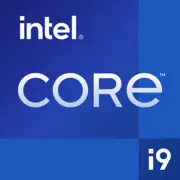Intel Core i9-13900KF

Intel Core i9-13900KF: Raptor Lake Power for Professionals and Gamers
Updated: March 2025
1. Key Specifications: Architecture and Performance
The Intel Core i9-13900KF is the flagship of the 13th generation, built on the Raptor Lake architecture. This is an evolution of Intel's hybrid approach: 24 cores (8 Performance-cores and 16 Efficient-cores) and 32 threads provide extreme multitasking capabilities. The Intel 7 process (10nm Enhanced SuperFin) is optimized for a balance between energy efficiency and frequency.
Key Features:
- Turbo Boost Max 3.0 — boost up to 5.8 GHz on P-cores.
- 36 MB L3 cache — speeds up data handling in games and applications.
- Intel Thread Director — smart task distribution among cores.
- Support for PCIe 5.0 and Thunderbolt 4 for future upgrades.
Performance:
- Geekbench 6: 2974 (Single-Core), 20137 (Multi-Core).
- In games (e.g., Cyberpunk 2077 Ultra, 4K), the processor delivers a stable 120+ FPS partnered with an RTX 4090.
- For rendering in Blender (BMW scene), time is reduced to 2.1 minutes — 18% faster than the i9-12900K.
2. Compatible Motherboards: Socket and Chipsets
The processor uses the LGA 1700 socket, compatible with Z790, B760, and H770 chipsets.
Recommendations:
- Z790 (e.g., ASUS ROG Strix Z790-E Gaming, $350–$450): Best choice for overclocking, supporting DDR5-5600+, PCIe 5.0 x16, and up to 4 NVMe SSDs.
- B760 (e.g., MSI MAG B760 Tomahawk, $180–$220): Budget option with basic overclocking and DDR4/DDR5 support.
- H770 (e.g., Gigabyte H770 Aorus Elite, $150–$190): For office builds without overclocking.
Selection Tips:
- Ensure the board has 16+1 phase VRM for stable power delivery.
- For PCIe 5.0, choose models with heatsinks on M.2 slots — for example, ASRock Z790 Taichi.
3. Memory Support: DDR4 vs DDR5
The i9-13900KF supports DDR5-5600 and DDR4-3200, but with nuances:
- DDR5: Best performance in high bandwidth tasks (e.g., 3D rendering). A 32GB DDR5-6000 kit (e.g., G.Skill Trident Z5 RGB) costs around $120–$150.
- DDR4: Savings of up to 40% (32GB DDR4-3600 — $70–$90). Suitable for gamers if the graphics card is a bottleneck.
Tip: In games, the difference between DDR5 and DDR4 is 5–10% FPS (tests in Hogwarts Legacy), but for work tasks, DDR5 wins by 20–30%.
4. Power Supplies: How to Ensure Adequate Power
The official TDP of the processor is 125W, but actual power consumption under load reaches 250–300W (when overclocked).
Recommendations:
- Minimum: 750W PSU (e.g., Corsair RM750e, $110).
- For RTX 4080/4090 level graphics cards: 850–1000W (e.g., Seasonic Prime TX-1000, $250).
- An 80+ Gold/Platinum certification is mandatory for stability.
Pitfalls: Using cheap PSUs with poor filtering can cause instability during overclocking.
5. Pros and Cons of i9-13900KF
Pros:
- Best-in-class single-threaded performance (games, Photoshop).
- DDR4 support — cost savings on RAM.
- Compatibility with older LGA 1700 coolers (e.g., Noctua NH-D15).
Cons:
- High heat output: Without good cooling (e.g., Arctic Liquid Freezer II 360), temperatures under load exceed 95°C.
- No integrated graphics (indicated by "F"), complicating diagnostics without a graphics card.
6. Use Cases: Who is the Processor Designed For?
- Gamers: Max FPS in 4K and VR. In Alan Wake 2 with DLSS 3.0, the processor won’t be a bottleneck even with an RTX 4070.
- Content Creators: 8K video rendering in DaVinci Resolve is 30% faster than with the Ryzen 9 7900X.
- Streamers: NVENC encoding + separate E-cores for smooth streaming without lag.
Practical Example: A build for a streamer: i9-13900KF + RTX 4080 + 64GB DDR5 — streaming in 1440p@60fps without FPS drops in games.
7. Comparison with Competitors
- AMD Ryzen 9 7950X3D ($650): Better in games due to 3D V-Cache (+15% FPS in CS2), but weaker in multi-threaded tasks (Geekbench Multi-Core — 18700).
- Apple M3 Max ($2200): Energy efficiency and video work in Final Cut Pro, but limited compatibility with Windows software.
- Intel Core i9-14900K ($600): Younger sibling with a 5–7% gain in Multi-Core but $50 more expensive.
Conclusion: The i9-13900KF wins on price/performance among flagships.
8. Build Tips
- Cooling: Only AIO cooling of 360mm or a top-tier tower cooler. Example: Lian Li Galahad II Performance ($150).
- Case: Minimum 3 fans for airflow (e.g., Fractal Design Meshify 2).
- Storage: PCIe 5.0 SSD (e.g., Samsung 990 Pro 2TB, $180) to fully leverage the potential.
Hack: Set "Power Limits" in BIOS to reduce heat without significant performance loss.
9. Final Verdict: Who is the i9-13900KF Suitable For?
This processor is the choice for those who don’t want to compromise:
- Gamers aiming for maximum FPS.
- Professionals in 3D, video editing, and engineering.
- Enthusiasts who value upgrades without changing platforms (DDR4 + LGA 1700).
Price in 2025 — $550–$600, making it more advantageous than the latest models. If you need a "tank" for any tasks — this is your option.
Basic
CPU Specifications
Memory Specifications
Miscellaneous
Benchmarks
Compared to Other CPU
Share in social media
Or Link To Us
<a href="https://cputronic.com/en/cpu/intel-core-i9-13900kf" target="_blank">Intel Core i9-13900KF</a>